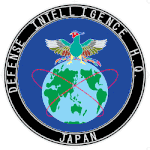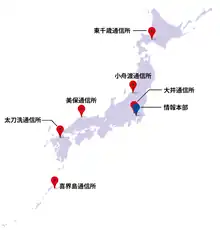| DIH 情報本部 Jōhōhonbu | |
 Official seal of the Defense Intelligence Headquarters | |
| Agency overview | |
|---|---|
| Formed | January 20, 1997 |
| Preceding agency |
|
| Jurisdiction | Japan |
| Headquarters | Ichigaya, Shinjuku, Tokyo, Japan |
| Employees | 2,451 personnel (2012) |
| Annual budget | ¥ 52.8 billion (2010) |
| Parent agency | Ministry of Defense |
| Website | Official Site (in Japanese) |
The Defense Intelligence Headquarters (情報本部, Jōhōhonbu)[1] is a military intelligence and signal intelligence agency of the Japanese government, under the jurisdiction of the Japanese Ministry of Defense. It is currently one of the biggest Japanese intelligence agencies,[2] with its creation and structure modeled after the American Defense Intelligence Agency.[3]
History

Back in the 1980s, the former Defense Agency had several intelligence divisions with different duties. Among these intelligence divisions in the Defense Agency had included those from the Central Data Command Unit, the Joint Staff Council's Second Office and the three branches from the chiefs of staff in the Japan Self-Defense Forces (JSDF).[4] Most of the DIH's establishment was based on the Second Investigation Bureau of the JGSDF.[5] They were involved in intercepting communications that led to and after the shooting of Korean Air Lines Flight 007.[5]
A supposed plan to integrate the intelligence divisions of the three JSDF branches started in 1988 before lack of cooperation and subordination ended it.[4]
Plans to consolidate all the intelligence bureaus of the old Defense Administration into one agency had started in the 1990s[6] after the National Diet had passed a law in May 1996, calling for the creation of a central military intelligence agency before the DIH was eventually established on January 20, 1997[3][7] after intelligence units from the JSDF, Japanese Defense Agency and the Joint Staff council are united[8] with the appointment of Lieutenant General Kunimi Masahiro as the agency's first commanding officer.[2] Initially, DIH civilian and military staff members were numbered at 1,580[7] with a planned manpower of 2,000 personnel[9] before it reached its current manpower of 2,300 staff members.[10][11] In 2011, the manpower is 1,907 members[12]
Spy satellites had been planned for launch in 1998 as part of augmenting the DIH's intelligence gathering capabilities. Though two were able to launch into space, two more were destroyed in a botch attempt to send them to space.[13]
In 2005, the DIH has suffered its first internal leak of classified information when a Colonel in the JASDF had been arrested for allegedly leaking information regarding the accident of a People's Liberation Army Navy Submarine that took place in the same year in the South China Sea.[14]
The DIH had announced in 2006 that a liaison office was established in Washington, D.C., with the National Security Agency.[15]
Known activities
- After a North Korean Taepodong-1 ballistic missile had been launched on August 31, 1998, JSDF ships and aircraft began to search the Sea of Japan to collect any debris of the missile with the DIH providing intelligence support such as dispatching North Korean specialists to the United States over the matter.[16]
- North Korean radio communications were intercepted by the SIGINT division's Kikaijima, Kagoshima radio monitoring station. The successful interception of North Korean communications later led to a naval shootout between ships of the Japan Coast Guard and a suspected North Korean spy boat in 2001 near the island of Amami-Ōshima before the latter had been destroyed.[17]
- The DIH had provided intelligence to JGSDF forces that were deployed in Indonesia during the 2006 Yogyakarta earthquake.[10]
- Using a signals intelligence facility in Tachiarai, the DIH reportedly monitor communications from transiting satellites, as part of a program codenamed MALLARD.[18] The program reportedly intercepts more than 12 million Internet communications per day.[18]
Command
The DIH is under the jurisdiction of the Joint Staff and is controlled by the Defense Intelligence Committee, which is made up of the Chiefs of Staff of the JGSDF, JMSDF and JASDF along with the Chief of Staff, Joint Staff, State Minister of Defense and the Minister of Defense.[19][20]
Command of the DIH was given directly to the Japanese Minister of Defense in March 2006.[10] The deputy officer is usually a civilian officially appointed by the MOD.[21] Four Defense Intelligence Officers (DIOs) are also appointed with three being colonels from the JGSDF or the JASDF with one a civilian official.[21]
The SIGINT facilities managed by the Chobetsu (Chosa Besshitsu) or the Annex Chamber, Second Section, Second Investigation Division in English, from 1958 to 1997 is managed by the DIH.[22] Command of the SIGINT division is usually filled by a senior officer appointed by the NPA from the Prefectural Police.[23][24]
Organization
A number of divisions were established under the DIH, including the following:[20][25]
| Directorate | Mandate |
|---|---|
| Directorate for Administration | Provides administrative and logistics support |
| Directorate for Programs | Conducts and plans DIH's intelligence collection/analysis plans. Serves as the point of contact when coordinating work with intelligence agencies in and out of the MOD. |
| Directorate for Geospatial Intelligence | Analyzes satellite images bought from commercial satellites or from the JGSDF's Central Geographical Command located in Tachikawa, Tokyo |
| Directorate for Signal Intelligence | Analyzes SIGINT intelligence. Is responsible for its electronics unit in Ichigaya to monitor North Korea-based communications. It also manages two CDAA 'elephant cages,' as well as six other communications offices. They are located in Kobunato, Niigata Prefecture, Oi, Saitama Prefecture, Tachiarai, Fukushima Prefecture and Kikaijima, Kagoshima Prefecture. |
| Directorate for Assessment | Summarizes/assesses intelligence from Japanese military attachés serving abroad, intelligence from friendly nations and from DIH collaborators and agents |
| Directorate for Joint Intelligence | Collect and analyse intelligence which is needed to cope with immediately, and support Chief of JSO and SDFs directly. This division is a part of DIH, but also is expected to be used as J-2 of JSO. |
Role
The main role of the DIH is to collect information and analyse for planning defense and operation policy. The agency collect information from open sources, signals and image intelligence as well as from other Japanese government ministries, Japanese embassies and other affiliated ministries and organizations.[10][25] In addition, they also gather intelligence through surveillance activities.[26]
It is not allowed to obtain non-military intelligence in Japan or information from cyberspace.[27]
Seal
The seal of the DIH consist of the following symbols:
Known DIH directors
DIH directors are usually positioned by a Lieutenant General from the JGSDF/JASDF or a Vice Admiral from the JMSDF.
- Fumio Ota[29]
- Kenichiro Hokazono; the former Chief of Air Staff
- Koji Shimohira
- Tadashi Miyagawa (宮川正)
References
- ↑ "部局課名・官職名英訳名称一覧" [Names of Government Organizations and Positions] (PDF). Retrieved June 9, 2008.
- 1 2 Andrew Oros. "Japan's Growing Intelligence Capabilities" (PDF). Archived from the original (PDF) on 2009-03-20. Retrieved June 9, 2008.
- 1 2 "NAPSNet Daily Report 24 January, 1997 | Nautilus Institute for Security and Sustainability". Nautilus Institute for Security and Sustainability | We Hold That It is Possible to Build Peace, Create Security, and Restore Sustainability for All People in Our Time. 24 January 1997. Archived from the original on 2019-05-23.
- 1 2 "Defence Intelligence Headquarters (DIH)". Archived from the original on 2020-01-11.
- 1 2 Davis and Gustafson, page. 184.
- ↑ "Japan, Intelligence and Security". December 25, 2019.
- 1 2 "Defence Intelligence Headquarters". Retrieved June 9, 2008.
- ↑ "[INDONESIA-P] CSM - Asia Eyes New J". Archived from the original on 2004-11-08.
- ↑ "Press Conference by the Press Secretary". Retrieved June 9, 2008.
- 1 2 3 4 (PDF) https://web.archive.org/web/20110930142605/http://www.mod.go.jp/e/publ/w_paper/pdf/2006/3-1-1.pdf. Archived from the original (PDF) on 2011-09-30.
{{cite web}}: Missing or empty|title=(help) - ↑ (PDF) https://web.archive.org/web/20080625185434/http://www.nids.go.jp/english/dissemination/briefing/2006/pdf/100.pdf. Archived from the original (PDF) on 2008-06-25.
{{cite web}}: Missing or empty|title=(help) - ↑ (PDF) https://web.archive.org/web/20130214001823/http://www.mod.go.jp/e/d_budget/pdf/231220.pdf. Archived from the original (PDF) on 2013-02-14.
{{cite web}}: Missing or empty|title=(help) - ↑ "With Eyes Wide Shut: Japan, Heisei Militarization and the Bush Doctrine". nautilus.rmit.edu.au. Archived from the original on 13 October 2009. Retrieved 11 January 2022.
- ↑ "The secrets of the sea". 7 April 2008. Archived from the original on 2016-04-10.
- ↑ "29 Sept 2006 news feed" (PDF). space-library.com. Archived from the original (PDF) on 2011-10-04.
- ↑ "Section 2. Response of the Defense Agency to the Missile Launch by North Korea". Retrieved June 16, 2008.
- ↑ "Japan's Secret SIGINT Organizations: Focusing On North Korea". Archived from the original on 2008-03-17. Retrieved June 15, 2008.
- 1 2 Gallagher, Ryan (May 19, 2018). "The Untold Story of Japan's Secret Spy Agency". Archived from the original on May 21, 2018.
- ↑ "防衛省・自衛隊:防衛省ウェブサイトのHttpsへの切り替えのお知らせ". Archived from the original on 2018-10-05.
- 1 2 "Japan Primer". University of Texas. 2007. Archived from the original on 2008-06-25. Retrieved 2007-10-06.
- 1 2 Yuki Tatsumi (November 2008). "JAPAN'S NATIONAL SECURITY POLICY INFRASTRUCTURE CAN TOKYO MEET WASHINGTON'S EXPECTATION?" (PDF).
- ↑ "Japan's Signals Intelligence (SIGINT) Ground Stations: A Visual Guide | Nautilus Institute for Security and Sustainability". 6 August 2015. Archived from the original on 2018-10-06.
- ↑ "【対北情報戦の内幕-13-】自衛隊が「工作船接近」を知りながら拉致事件を見逃した理由".
- ↑ Dover, Goodman and Hillebrand, page 203
- 1 2 "防衛省・自衛隊:防衛省ウェブサイトのHttpsへの切り替えのお知らせ". Archived from the original on 2009-04-18.
- ↑ "Section 3 Organization of the MOD/SDF" (PDF). Archived from the original (PDF) on 2017-03-22.
- ↑ "Japan's Five Eyes chance and challenge". East Asia Forum. August 26, 2021.
- 1 2 3 4 "防衛省・自衛隊:防衛省ウェブサイトのHttpsへの切り替えのお知らせ". Archived from the original on 2007-07-14.
- ↑ "U.S. To aid Japan with defensive missile test | the San Diego Union-Tribune". www.sandiegouniontribune.com. Archived from the original on 5 March 2016. Retrieved 11 January 2022.
Bibliography
- Davies, Philip H.J.; Gustafson, Kristian, eds. (2013). Intelligence Elsewhere: Spies and Espionage Outside the Anglosphere. Georgetown University Press. ISBN 978-1589019560.
- Dover, Robert; Goodman, Michael S.; Hillebrand, Claudia, eds. (2014). Routledge Companion to Intelligence Studies. New York: Routledge. ISBN 978-1589019560.
- Samuels, Richard J. (2019). Special Duty: A History of the Japanese Intelligence Community. Cornell University Press. ISBN 978-1501741586.
External links
- Official Site (in Japanese)